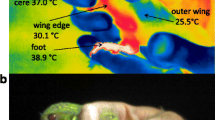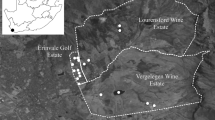Summary
The body water content and resistance to desiccation were studied in two perimylopid beetles, Perimylops antarcticus and Hydromedion sparsutum, a chironomid midge, Eretmoptera murphyi, and two spiders, Notiomaso australis and Perimaso grytvikensis from the subantarctic island of South Georgia. Comparisons were made between different species, different life stages and, where possible, between a high and a low altitude. Perimylops is abundant at higher elevations and in more exposed habitats (fellfields). This may be accounted for by its feeding behaviour, high body water content (relative to Hydromedion) and low rate of water loss under desiccating conditions, particularly in the larval stages. Hydromedion is more abundant at the lower collection site. It is a more robust beetle than Perimylops and its feeding preference is for plants such as grasses and Acaena. Nevertheless, at the upper site adult Hydromedion are able to withstand desiccation to an even greater degree than Perimylops. Water loss rates for both beetles are significantly higher than those reported for related beetles from arid and semi-arid regions. The ability to regulate water loss is not as apparent in the polar perimylopids Perimylops and Hydromedion as in related species from other xeric habitats. These two species, in fact, resemble more closely carabid beetles in xeric habitats in rates of water loss under controlled conditions. Increased temperatures elevate the rate of water loss significantly. South Georgia spiders have a similar rate of water loss to several species of spiders that have been studied in the temperate zone. Eretmoptera is restricted to moist conditions and cannot survive desiccating conditions even for brief periods. It has the highest body water content (78% of fresh weight) of all of the South Georgian arthropods studied. Among the spiders, sufficient information could be obtained only for Notiomaso. This species is much less resistant to desiccation than the perimylopid beetles, and it has a relatively high body water content. It is quite numerous in the lower, warmer habitats where its insect prey is more abundant and diverse.
Similar content being viewed by others
References
Baehr B, Eisenbeis G (1985) Comparative investigations on the resistance to desiccation in Lycosidae, Hahniidae, Linyphiidae and Micryphantidae (Arachnida, Araneae). Zool JB (Syst) 112:225–234
Block W (1984) Terrestrial microbiology, invertebrates and ecosystems. In: Laws RM (ed) Antarctic ecology, vol 1. Academic Press, London, pp 163–236
Block W (1988) South Georgian entomology. Antenna 12:97–102
Block W, Sømme L (1983) Low temperature adaptations in beetles from the sub-Antarctic island of South Georgia. Polar Biol 2:109–114
Block W, Sømme L, Ring RA, Ottesen P, Worland MR (1988) Adaptations of arthropods to the sub-Antarctic environment. Br Antarct Surv Bull 81:65–67
Brundin L (1970) Diptera: Chironomidae of South Georgia. Pac Insects Monogr 23:276
Cannon RJC, Block W (1988) Cold tolerance of microarthropods. Biol Rev 63:23–27
Edney EB (1977) Water balance in land arthropods. Zoophysiol Ecol 9:282 pp Springer, Berlin
Edwards M, Usher MB (1985) The winged antarctic midge Parochlus steineni (Gerke) (Diptera: Chironomidae) in the South Shetland Islands. Biol J Linn Soc 26:83–93
Forster RR (1970) Araneae: Spiders of South Georgia. Pac Insects Monogr 23:31–42
Gressitt JL (1970) Subantarctic entomology, particularly of South Georgia and Heard Island. Pac Insects Monogr 23:1–374
Headland R (1984) The Island of South Georgia. Cambridge University Press, Cambridge, UK, 293 pp
Leinaas HP, Sømme L (1984) Adaptations in Xenylla maritima and Anurophorus laricis (Collembola) to lichen habitats on alpine rocks. Oikos 43:197–206
Ottesen P, Sømme L (1987) Adaptations to high altitudes in beetles from Tenerife. Vieraea 17:127–226
Peckham V (1971) Notes on the chironomid midge Belgica antarctica Jacobs at Anvers Island in the maritime antarctic. Pac Insects Monogr 25:145–166
Ring RA (1980) Insects and their cells. In: Low temperature preservation in medicine and biology. Ashwood-Smith, MJ, Farrant J (eds) Pitman Medical Publ Co, Tunbridge Wells (UK), pp 187–217
Ring RA, Tesar D (1980) Cold-hardiness of the arctic beetle, Pytho americanus Kirby (Coleoptera, Pythidae (Salpingidae)). J Insect Physiol 26:763–774
Salt RW (1961) Principles of insect cold hardiness. Annu Rev Entomol 6:55–74
Smith RI Lewis, Walton DWH (1975) South Georgia, subantarctic. Ecol Bull 20:399–423
Sømme L, Ring RA, Block W, Worland MR (1989) Feeding in two phytophagous beetles Hydromedion sparsutum and Perimylops antarcticus from South Georgia. Polar Biol 10:141–143
Storey KB, Storey JM (1988) Freeze tolerance in animals. Physiol Rev 68:28–84
Vogel M (1985) The distribution and ecology of epigeic invertebrates on the subantarctic island of South Georgia. Spixiana 8:153–163
Watt JC (1970) Coleoptera: Perimylopidae of South Georgia. Pac Insects Monogr 23:243–253
Worland MR, Block W, Sømme L, Ring RA (in press) Microclimates in fellfield and grassland habitats at South Georgia. Antarct Sci
Zachariassen KE, Andersen J, Moloiy GMO, Kamau JMZ (1987) Transpiratory water loss and metabolism of beetles from arid areas in East Africa. Comp Biochem Physiol 86A:403–408
Zar JH (1984) Biostatistical analysis, 2nd edn. Prentice-Hall Inc Publ, Englewood Cliffs NH, 718 pp
Author information
Authors and Affiliations
Rights and permissions
About this article
Cite this article
Ring, R.A., Block, W., Sømme, L. et al. Body water content and desiccation resistance in some arthropods from subantarctic South Georgia. Polar Biol 10, 581–588 (1990). https://doi.org/10.1007/BF00239369
Received:
Accepted:
Issue Date:
DOI: https://doi.org/10.1007/BF00239369




